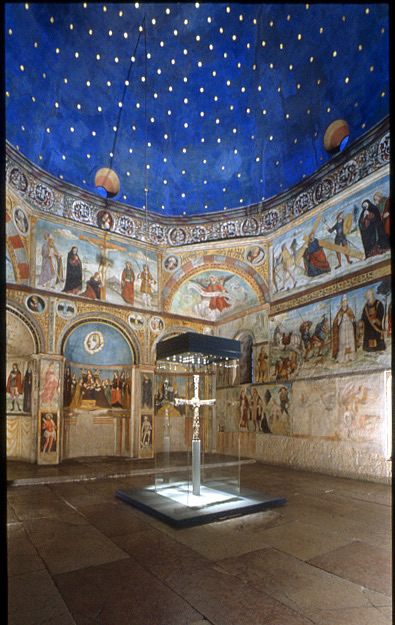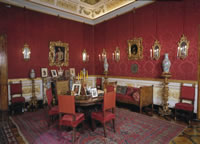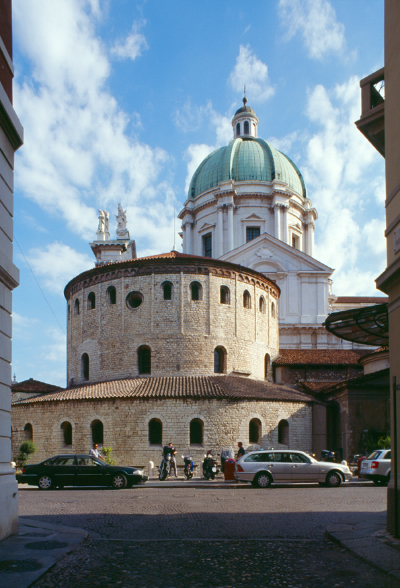|
The news about the origins of Brescia are lost in the night of the times, trepassing in the legend: the theories about the identity of the founder are manifolds (Ercole, Troe or Tiras or Cidno, king of Ligurian, from whom the name of the hill Cidneo, at the doors of the town) while the origins of the name of the town Brixia are to seek in the domination of Galli Cenomani. In 49 B.C. it is roman town at all effects and lives some centuries of splendour, until at the ruin of the Roman Empire; followed the barbaric invasions, last of which that of the longobards that was established in the north Italy and made of Brescia one of their most important dukedoms. Their government was not wretched, but the strained terms with the Curch disembogued into war and king Desiderio tried an alliance with the frank, but, for all answer, Carlo Magno at stand of the papal troops besieged in 773 Pavia and Verona, forcing king Desiderio at the exile.  The domination of the Frank lasted until at 888. The domination of the Frank lasted until at 888.
With the fall of the Holy Roman Empire begins for Brescia a difficult period, at the centre of the disputes between the Duke of Spoleto and the Marquis of Friuli. In 1090 is born the Common of Brescia, guelph, between the ghibelline commons and afterwards in continuous guerilla. The invasion of Federico I was the cause for which the commons decided for a truce and allied themselves, unfortunately without result. In fact, afterwards of the defeat of Milan, the other commons, between whose Brescia, made a promise of obedience, undergoing at terms of surrender that included the demolition of the wall and of the towers. Was in 1167 that, with an secret alliance, Brescia, Bergamo, Mantova, Cremona and Milan gave life at the battle of Legnano from that Federico Barbarossa came out defeated. After only ten years however Brescia should face Federico II and after 66 days of bloody siege the Emperor was surrendered. The successive decades were a continuous alternation of seizures of power from different rules until at the invasion of Arrigo VII in 1311. For Brescia was still years of internal battles and of passages of hand between that terrible is metioned the siege of Niccolò Piccinino, that reduced Brescia at the hunger, exhausted from the plague and almost entirely destroyed, but done not win, thanks also at the help of Venice.
In 1440 Brescia returned free and under its jurisdiction were consolidated the Valle Camonica and the territory of the province. The tension with Venice had end only when the common with the fear of an turkish invasion carried the two town do not disperse the strength and initial the peace of Lodi. In 1508 yet, Pope Giulio II interfered to oppose the rise of the venetian power: allied with Austria, Spain, anf France, engaged a battle against the venetian army and won; Luigi XII of France came in town and governed for four years. In 1512 exploded the revolt, tamed in the blood from the french, swiss and german troops. The french surrendered Brescia at the spanish that occupied it before that came signed the agreement; Venice was in meantime worried lose Brescia for its strategic position and allied itself with french to free it from the spanish: after six months Brescia was free from the spanish domination and Venice reinforced all the logistics defences of the town. Meanwhile mercenary armies and foreign troops railed for the north Italy, sacking and killing, and Venice suffered a slow impoverishing. Brescia began want the independence and the freedom, also on the wave of the ideal of the french Revolution and in march 1797 exploded the revolt: for eight months Brescia lived like a small inependent republic and with the treaty of Campoformio between Austria and France was attached at the Cisalpina Republic.
From 1799 at 1800 Brescia is again in austrian hands, but Napoleon, june 10, retakes the power on Brescia, making revive the Cisalpina Republic that in 1805 grew into Kingdom of Italy. At the impoverishing of the napoleonic empire Austria attached again Brescia at own territory, but the concepts of freedom of the french revolution had definitively altered the mentality of the bresciani, so that the town arose against the austrian in its Ten Days: Brescia march 23 1849 arose against the Austrian; for ten day endless the Bresciani held head at the austrian army of the captain Loeschke, barricaded indoors the wall of the castle. From the town of the "quadrilateral" (Mantova, Peschiera, Verona and Legnano) rushed the reinforcements, at the command of the general Haynau. The resistance of the town-dwellers was furious but was choked in the blood. April first 1849 the Austrian developed a decisive assault against all the gates of the town, the patriots that did not succeed to flee came shot and the imperial soldiers were abandoned at cruelty and ferocities of every type. Compeled at the surrender, from that day earned the title of Lioness of Italy. During the Second War of Independence (1859-1861), pidemontese and french defeated at high price the austrian-hungarian army, Napoleon III signed the peace of Vilafranca that decided between the other the liberation og the whole Lombardy and Brescia was attached at the Kingdom of Italy. At the impoverishing of the napoleonic empire Austria attached again Brescia at own territory, but the concepts of freedom of the french revolution had definitively altered the mentality of the bresciani, so that the town arose against the austrian in its Ten Days: Brescia march 23 1849 arose against the Austrian; for ten day endless the Bresciani held head at the austrian army of the captain Loeschke, barricaded indoors the wall of the castle. From the town of the "quadrilateral" (Mantova, Peschiera, Verona and Legnano) rushed the reinforcements, at the command of the general Haynau. The resistance of the town-dwellers was furious but was choked in the blood. April first 1849 the Austrian developed a decisive assault against all the gates of the town, the patriots that did not succeed to flee came shot and the imperial soldiers were abandoned at cruelty and ferocities of every type. Compeled at the surrender, from that day earned the title of Lioness of Italy. During the Second War of Independence (1859-1861), pidemontese and french defeated at high price the austrian-hungarian army, Napoleon III signed the peace of Vilafranca that decided between the other the liberation og the whole Lombardy and Brescia was attached at the Kingdom of Italy.
The evidences of the long and tormented story of the town are in the roman remains, medieval palaces, gothic churches, renaissance works of art accomodated in city churches and museums. We remember, between the roman reperts, the Tempio Capitolino, erected in 73 B.C. for order of tne Emperor Vespasiano, that is in the archeological zone, the Foro, where can be admired also the Roman Theatre and the Cathedral.
Of medieval epoch the Monastero Benedettino of Santa Giulia of 753 A.C., today seat of the Museum of the Town, the Broletto Palace with the Torre del Pegol, the Castle of Brescia and the Ancient Cathedral, one of the rare example of church at circular plan where is preserved the Tresaure of Santa Croce of Incalculable value. The Renaissance has gave instead place of the Loggia and Martinengo Palace, seat of the homonym Picture-Gallery. Arriving finally at monuments and artistic goods of '700 and '800, we quote: the Theatre Grande, the Queriniana Library and the New Cathedral.
 The beauties of the zone, however, are not depleted with monuments of the town: the territory of its province enchants for the variety and the rich of natural beauties: from the fertile plain of the southern zone at the high summits of the group of the Adamello. from the banks of the lake of Iseo at those of the lake of Garda is a follow each other of closes, of routes and of pleasing opportunity for the tourist that wish amuse himself, practice summer or winter sport, relax himself and enjoy of some therapeutic property of the waters of the numerous Thermal establishments of the zone. The beauties of the zone, however, are not depleted with monuments of the town: the territory of its province enchants for the variety and the rich of natural beauties: from the fertile plain of the southern zone at the high summits of the group of the Adamello. from the banks of the lake of Iseo at those of the lake of Garda is a follow each other of closes, of routes and of pleasing opportunity for the tourist that wish amuse himself, practice summer or winter sport, relax himself and enjoy of some therapeutic property of the waters of the numerous Thermal establishments of the zone.
Deserves surely a visit the National Park of the Incisioni Rupestri of the Valle Camonica, property of UNESCO, where, immersed in a pure landscape, can be admired evocative graffiti left from the Camuni, the mst ancient go back at the over 10.00 years ago; besides there is the Archeodromo, a paleolitc village rebuilded and a Didactic Museum of prehistoric art and life.
The presence of the lakes in the eastern zone of the territory gives back specially moderate the climate although the latitude and allows the cultivation of vines, olive-trees and citrus fruits, in specail way on the shore of Garda; achives a dainty and renowned production of wines (Franciacorta, Classic Garda, Lugana, San Martino of the Battaglia) and of extravergin olive-oil (Oil of Garda DOP) that are accompanied with the other products and typical dishes: cheeses, cold cuts, polenta, casoncelli (ravioli with different stuffed from zone at zone), fish of fresh water, frogs and snails. |



 Munch: The Scream Within
Munch: The Scream Within In the garden
In the garden Perugia Travel Guide
Perugia Travel Guide


 The domination of the Frank lasted until at 888.
The domination of the Frank lasted until at 888. At the impoverishing of the napoleonic empire Austria attached again Brescia at own territory, but the concepts of freedom of the french revolution had definitively altered the mentality of the bresciani, so that the town arose against the austrian in its Ten Days: Brescia march 23 1849 arose against the Austrian; for ten day endless the Bresciani held head at the austrian army of the captain Loeschke, barricaded indoors the wall of the castle. From the town of the "quadrilateral" (Mantova, Peschiera, Verona and Legnano) rushed the reinforcements, at the command of the general Haynau. The resistance of the town-dwellers was furious but was choked in the blood. April first 1849 the Austrian developed a decisive assault against all the gates of the town, the patriots that did not succeed to flee came shot and the imperial soldiers were abandoned at cruelty and ferocities of every type. Compeled at the surrender, from that day earned the title of Lioness of Italy. During the Second War of Independence (1859-1861), pidemontese and french defeated at high price the austrian-hungarian army, Napoleon III signed the peace of Vilafranca that decided between the other the liberation og the whole Lombardy and Brescia was attached at the Kingdom of Italy.
At the impoverishing of the napoleonic empire Austria attached again Brescia at own territory, but the concepts of freedom of the french revolution had definitively altered the mentality of the bresciani, so that the town arose against the austrian in its Ten Days: Brescia march 23 1849 arose against the Austrian; for ten day endless the Bresciani held head at the austrian army of the captain Loeschke, barricaded indoors the wall of the castle. From the town of the "quadrilateral" (Mantova, Peschiera, Verona and Legnano) rushed the reinforcements, at the command of the general Haynau. The resistance of the town-dwellers was furious but was choked in the blood. April first 1849 the Austrian developed a decisive assault against all the gates of the town, the patriots that did not succeed to flee came shot and the imperial soldiers were abandoned at cruelty and ferocities of every type. Compeled at the surrender, from that day earned the title of Lioness of Italy. During the Second War of Independence (1859-1861), pidemontese and french defeated at high price the austrian-hungarian army, Napoleon III signed the peace of Vilafranca that decided between the other the liberation og the whole Lombardy and Brescia was attached at the Kingdom of Italy. The beauties of the zone, however, are not depleted with monuments of the town: the territory of its province enchants for the variety and the rich of natural beauties: from the fertile plain of the southern zone at the high summits of the group of the Adamello. from the banks of the lake of Iseo at those of the lake of Garda is a follow each other of closes, of routes and of pleasing opportunity for the tourist that wish amuse himself, practice summer or winter sport, relax himself and enjoy of some therapeutic property of the waters of the numerous
The beauties of the zone, however, are not depleted with monuments of the town: the territory of its province enchants for the variety and the rich of natural beauties: from the fertile plain of the southern zone at the high summits of the group of the Adamello. from the banks of the lake of Iseo at those of the lake of Garda is a follow each other of closes, of routes and of pleasing opportunity for the tourist that wish amuse himself, practice summer or winter sport, relax himself and enjoy of some therapeutic property of the waters of the numerous